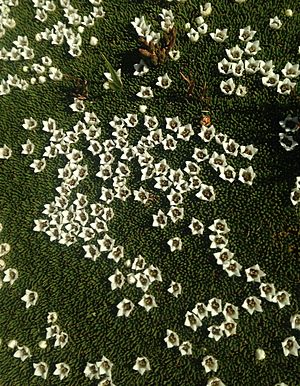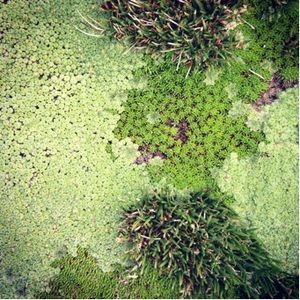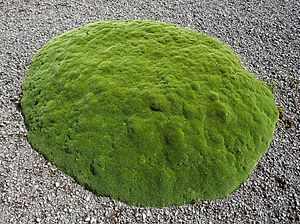Tasmanian cushion plants facts for kids
Tasmanian cushion plants are amazing plants that grow low to the ground, forming tight, dense mats. These mats can spread out up to 3 meters wide and are mostly found on the island of Tasmania. They are made of stems packed very closely together. All the stems grow at the same speed, so no part sticks out higher than the rest.
The name "cushion plant" describes how these plants grow. Many different types of plants have developed this special way of growing. It helps them survive in tough, cold places like mountains or very far north or south. These plants are good at growing where there isn't much food in the soil. They usually have long roots that go deep into the ground. Cushion plants grow very slowly and stay low, usually less than 30 centimeters tall. Underneath the green, living top layer, dead leaves or other plant parts build up. This creates a warm, insulating blanket for the plant.
Contents
Meet Tasmania's Cushion Plants
There are seven different types of cushion plants found in Tasmania. They belong to six different plant families. One more type of cushion plant is found on Macquarie Island. Some other plants can also grow in a similar cushion shape, even if it's not their only way of growing. The way these plants grow helps them control how water flows around them.
| Family | Scientific name | Common name | What it looks like |
|---|---|---|---|
| Asteraceae | Abrotanella forsteroides | Tasmanian cushionplant | This plant is only found in Tasmania. Its leaves are bright green, thick, and packed together. They have a pointed tip. Its tiny white flowers look like daisies and sit just above the leaves. |
| Asteraceae | Pterygopappus lawrencei | Sage cushionplant | This plant is also only found in Tasmania. It forms a compact, blue-green cushion. Its leaves are tiny, thick, and overlap closely. They have pointed tips and a silky, hairy base. Its single white daisy-like flowers sit just above the leaves. |
| Caryophyllaceae | Colobanthus pulvinatus | Cushion cupflower | This is a firm, stiff cushion plant. It has spiky leaves that are 2 to 5 millimeters long with thick edges. Its yellow-green, cup-shaped sepals are hidden in the leaves. This plant is considered rare in Tasmania. It is also found in New South Wales, Australia. |
| Donatiaceae | Donatia novae-zelandiae | Snow cushionplant | This plant forms a bright green, hard, and compact cushion. Its leaves are thin, fleshy, and pointed, about 5 to 6 millimeters long. They have fine hairs at the base. Its single white flowers have 5 petals and grow at the same level as the leaves. This plant is also found in New Zealand. |
| Epacridaceae | Dracophyllum minimum | Claspleaf heath | This plant is only found in Tasmania. It forms a dense, hard, mounding cushion with many branches. Its leaves are thick, stiff, and broad, with a hard point. Its white, tube-shaped flowers sit right on top of the leaves. |
| Scrophulariaceae | Veronica ciliolate | Ben Lomond cushion plant | This plant is only found in Tasmania. It forms a soft, rounded cushion. Its light green leaves are packed tightly in groups at the base. They are 2.5 to 4 millimeters long and have a tuft of silky hairs at the tip. Its flowers have 5 white petals. A special type of this plant is considered vulnerable. |
| Stylidiaceae | Phyllachne colensoi | Yellow cushionplant | This is a dense, tufted cushion plant with a clear yellowish color. Its leaves are wider at the bottom and get narrower to a blunt tip. They are 3 to 4 millimeters long and packed tightly around the stem. Its white flowers are single and have 5-6 spreading parts. This plant is also found in New Zealand. |
| Apiaceae | Azorella macquariensis | Macquarie cushions | This plant is only found on Macquarie Island. Its leaves are shaped like a kidney, with 3 or 5 pointed parts. Its flowers are single. This plant is listed as endangered and critically endangered. |
How Cushion Plants Evolved
Cushion plants are a great example of something called convergent evolution. This means that different types of plants, which are not related and live on different continents, have all developed the same cushion shape. They did this to help them survive in similar harsh environments around the world.
How Cushion Plants Help Their Ecosystem
Cushion plants are often called a keystone species in their environment. This means they are super important, and without them, the whole ecosystem would change a lot. For example, Azorella macquariensis is the only cushion plant on Macquarie Island. It is a main part of the plant life there.
Cushion plants are also known as "nurse species." This means they create a safe and helpful place for many other mountain plants to grow. They help other plants get started and survive. Cushion plants can even increase the number of different plant types in areas where there aren't many. Their low, compact shape helps them make the harsh mountain conditions easier for other plants.
Some Tasmanian cushion plants have a surface temperature that is up to 10°C warmer than the air around them. These warmer temperatures allow the plants to keep making their own food and growing. This helps them grow for a much longer time each year. Also, the dead leaves under the cushion and the peaty soil keep the roots from freezing. This means the temperature around the roots stays above -1°C. Other plants nearby have learned to rely on these conditions that cushion plants provide. They can only survive and grow where cushion plants are present.
Threats to Cushion Plants
Three types of Tasmanian cushion plants are currently in danger. These are Veronica ciliolata (a special type called fiordensis), Azorella macquariensis, and Colobanthus pulvinatus.
The Tasmanian Veronica ciliolata subspecies fiordensis is considered vulnerable. This means it could become endangered if things don't change. There are only about 1,500 to 2,000 mature plants left. Here are some things that threaten it:
- New ski areas and other building projects on the Ben Lomond plateau, where these plants live.
- Climate change and warmer temperatures. If their cold mountain homes shrink, these plants might not have anywhere to go.
- Random events like landslides, dry periods, diseases, or accidental damage. Because there are so few of them, these events can be very harmful.
Azorella macquariensis, found only on Macquarie Island, is listed as endangered and critically endangered. This means it's in extreme danger of disappearing forever. Since 2008, many of these plants have died, and their numbers have dropped very quickly. Scientists are still trying to figure out why this is happening. When these cushion plants die, the soil can wash away. This would be very bad for the other plants that rely on them. Possible threats to Azorella macquariensis include:
- Climate change. If temperatures rise, the soil gets drier, there's less rain, or more frosts happen, these plants are at risk.
- New species arriving. If new plants, animals, or diseases are brought to the island, they could harm the cushion plants. This could happen directly, like through infection, or indirectly, by damaging their home.
Colobanthus pulvinatus is listed as rare. This means there aren't many of them, and they need to be protected.




